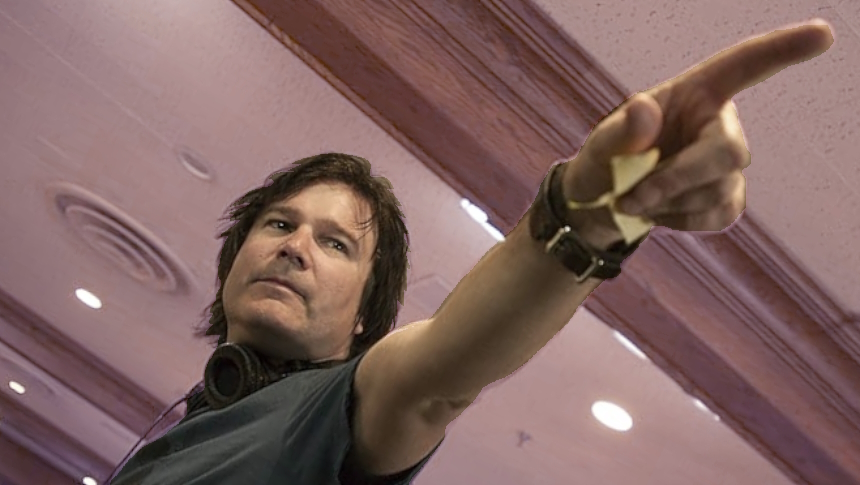Sound And Vision: Gore Verbinski

In the article series Sound and Vision we take a look at music videos from notable directors. This week: Gore Verbinski's music videos.
Gore Verbinski has had an erratic career, going from big blockbusters to weird passion projects. With genres that run the gamut from comedy, to horror, to swashbuckler, even dipping his stylistic toes into animation. Still, there are many visual and thematic throughlines in his oeuvre, some of which also showed up in his music video days. By looking at three music videos, I want to highlight three different Verbinski-isms.
Over the course of his career several images return. One of those is creepy crawlies, like pill bugs (Rango) or crabs (Pirates of the Caribbean: At World's End) or mice (Mouse Hunt) carrying something or other to the other side. The constant Rube Golberg-machines, where the cause-and-effect of action-reaction is ever-present in the action sequences that are built like clockwork around things falling on other things and causing havoc. But one other image that shows up in the weirdest of places is that of a slowly moving giant object or person. Picture Tia Dalma in the aforementioned Pirates of the Caribbean-movie, or the giant floating wind-up toy fish in Rango, or even the Spongebob-float in New York's Macy's Parade in The Weather Man. That might be a vast array of movies, the way in which these images are shot and shown are all eerily similar. And they show up in one of his music videos as well: Monster Magnet's Negasonic Teenage Warhead (below) is all about this particular image. In it, the band float on comets in space that are all being used as living room areas. The messy apartments are full of Verbinski-isms, like aquariums (see Rango, A Cure for Wellness and more), a mouse in a fridge (Mouse Hunt )and people framed in front of a television shot from the TV-sets POV (The Ring, The Weather Man, even Rango in some way). But the people in their comet-squats are being targeted by an ethereal space woman, a giantess, slowly floating and targeting the men. It is vintage Verbinski.
The Ring starts with a large, interesting rant about the viral influence of media, a thesis of the film itself, laid out in front of us. Verbinski likes to deconstruct media in his film, with a large reference for the past of the genres he dabbles in. From the (underwater) zombie movie and the swashbuckler in the Pirates-franchise, to Buster Keaton and the American western in The Lone Ranger, from Chinatown and the Spaghetti Western in Rango. In all of these movies there will be a moment of a fourth-wall break, in which the genre itself is addressed, and the audience becomes part of the movie in some way. The Ring's denouement, taken from the ending of the original J-horror movie, itself is about the ultimate fourth wall break: the living embodiment of something shown on a television screen killing a character. So it's fitting that the last music video Verbinski made, around the same time as The Ring and the first Pirates-film is itself a music video about a similar embodiment of past cinema. In The Crystal Method's Born Too Slow (also below), a character based on the photographs of Eadweard Muybridge comes to live. Muybridge was a photographer whose experiments with sequential imagery are often seen as one of the big progenitors of cinema itself. So, what does the Ghost of Cinema do? It walks across Los Angeles, manipulates its environment, bringing it to life, and is confronted with a future version of itself in a dance-off. Cinema!
The final shot of The Ring is also more than slightly present in an earlier music video of Verbinski, Bad Religion's 21st Century Digital Boy (finally below), which is about tv static coming to life. The idea that the television frame is a living, textured, touchable thing is the lynchpin of The Ring-franchise in some ways, and is present here. But the touchable textured thing here is liquid. And there-in shows the last Verbinski-ism: an ever-present obsession with and a reference for water. Most films of Verbinski fall in one of two camps: the one that are about harsh environments where there is a lack of water, where water is the giver of life, noted by its absence (The Mexican, The Lone Ranger, Pirates of the Caribbean: At World's End but especially Rango) or the one were water is present in abundance, so much so that it becomes a destructive force. See the Pirates-films, the final destruction of the house in Mouse Hunt, Samara being signified by water from the well oozing where it shouldn't be and the entire premise of A Cure for Wellness. Even The Weather Man, a seeming outlier in Verbinski's oeuvre, is all about the fickleness of the weather, and how the media simplifies it, having a huge impact on the life of the protagonist. That Verbinski made a music video that combines his obsession with media commentary with his obsession with water might have predicted the course of his career to come. 21st Century Digital Boy is sort of the missing link between The Ring and The Weather Man, in the same way that the other two highlighted music videos are reminiscent of wildly diverging movies like Mouse Hunt, Rango, The Lone Ranger and The Ring. Verbinski's oeuvre runs the gamut. But his works are also quintessentially his. The same goes for his music videos.






